I’ve been in my house with my wife for about 15 years now and life has changed a lot in that time. When we first got ADSL2, we had Ethernet cables running down the hallway into the living area to provide our DVR with connectivity. Then one of the bedrooms became a bit of a geeks lair, networked well and upgraded to a WiMax connection which required some networking through the house – my first mistake!
Because of a few factors, primarily available time, I did a quick and dirty (read cheap) job of the wiring. With a single network port in the living room, a single port in the spare bedroom a single port in the master bedroom and a 4 port wall panel in the lair. These four ports connected to the other ports mentioned and the 4th went to the WiMax dish on the roof. Over time little bits have been added to the network for extra hardware that required connectivity and it’s bitten me in the ass more than once.
At the time I wasn’t really thinking about future-proofing the system, possibly because kids weren’t on the radar at the time. Roll forward a few years, things 1 and 2 had arrived and the lair became my daughter’s bedroom. Not really a problem, but it’s added some clumsiness and complexity to the network, it’s also meant that she’s disconnected me more than once…
Now my PC (as well as some other hardware) in the master bedroom connects to the router, through a switch that goes via the cable into my daughter’s room, which goes through the roof to the living room and a long cable over the doorframe and the franken-network was born. It’s been OK for a number of years, but with recent changes and my kids getting older it’s very soon going to become an issue for me and it’s time to take action.
Planning the layout and thinking about growth
One of the major factors that drove the decision to finally clean up the network was the fact that we’ve recently pulled the trigger on a solar battery for our home. This requires a permanent, ethernet-based internet connection and frankly… my router is full. So it was time to make a change and plan for the future of my home network, even going overkill to make sure I don’t need to do it again anytime soon.
I had to start by thinking about connectivity around the home and what I may need in the future. The master bedroom where my desk needs multiple ports because I play with test a lot of hardware. Multiple ports behind the TV and make sure we have some spares as well given the nature of connected entertainment is only growing.
Both the kids’ rooms need at least one port in them and the port in my son’s room just isn’t in a good spot right now so we’re adding another. Everything else around the home now and for the foreseeable future will be wirelessly connected.
So the final plan is
- 4 ports in the master bedroom by my desk
- 1 port (replacing the mess of ports) in my daughter’s room
- 1 new port behind my son’s desk
- 5 new ports in the living room behind the TV
- Upgrade the existing port cables to cat6
- A cable needed to be attached to the patch panel for the solar battery
- We needed expand-ability for the future…
There was some brief consideration to putting Cat6E cable through, but we just don’t need it for the length of runs we’re using. That and the fact that we’re unlikely to exceed gigabit bandwidth in our home so we happily settled on Cat6.
Hardware decisions
Let’s start at the top, the house needs connectivity and we’ve got it. FTTP NBN which is currently running 100/40 speeds and generally we’re really happy with it. We also know that if we have a need in the future, we can get Gigabit downloads through a couple of ISPs.
Our current hardware
That’s connected to the house via a Netgear Nighthawk router which still meets the family’s needs. A router is very easily swapped out, so no real need to worry about this right now.
We have a really good NAS (Nimbustor 4) that meets all of our current storage, server and media streaming requirements. It’s connected via Ethernet and is capable of dual Gigabit connections although we’re only using one at the moment. It’s got plenty of storage for now, as well as expandability so we don’t need to worry about that for quite some time either.
We’ve got an HP Proliant Microserver which (until recently with the NAS upgrade) served us faithfully for over 10 years. It ran as an email server, web server, VPN server, PiHole server and other various projects I played with over the years. It’s got plenty of life left in it, but I’m not sure it will serve any purpose moving forward once we migrate the last of our data to the NAS.
Waaaay back in 2017, I got an HD Homerun Connect, hooked it up and left it under my desk. It’s a great little piece of kit and compliments Plex (or other home streaming software like Kodi) exceptionally well. All you need is a Digital TV antenna, power and network access then it’s a case of set and forget. I’d love to upgrade it to the newer version, but with this project plus other wallet-draining things going on at home – $350 is hard to justify.
We’ve got some home security camera equipment that has a control unit that plugs into the network. Another piece of hardware that was set up and hasn’t been touched since, so it’s something that could easily disappear from our home entertainment unit somewhere with zero consequence.
I’ve got a couple of Raspberry Pi floating around that will probably end up recommissioned (because I can…) when this is all completed. So having the capacity to further expand the hardwired network is important to me. So there’s a lot to consider with planning the network and that’s before considering any new hardware we may need. This is a venture that members of our team have been through before building houses in recent history.
So what do we need?
What I really wanted to achieve with this upgrade was to remove a heap of mess form our network. A central point where the network could be managed and controlled so we made some space in one of my son’s cupboards. It’s got enough space to deal with all of the hardware we’re likely to need and is large enough to deal with a little bit of heat build-up too. A quick measure confirmed my suspicions, a 6U rack frame will fit in there with space to spare.
I procured some important equipment to make this happen how I wanted it to. A LinkBasic 6RU Wall Mount Open Frame Rack and an Astrotek 24 Port CAT6 rack-mount Patch Panel which cost me $150 including freight. I’m only going to use 2U of the 6 to start with (patch panel and switch) and 14 of the 24 ports on the patch panel.
Given I only need to use 8 ports of the planned network ports in the house, plus a further 5 items directly to the switch a 16 port gigabit switch was always going to be sufficient. I’ve picked up a D-Link Gigabit rack-mount switch (DGS-1016D) which has some great power-saving and heat reduction features, handy for the job and space it’s going to be in.
The final pieces of the puzzle were going to be getting licenced tradies in to complete the tasks. The cupboard will need power for the hardware, a network cabler to terminate cables to code and an antenna port in the cupboard for my HD Homerun.
The end result
We’ve removed a number of items from our network which will increase the power efficiency. We’ve physically moved a number of items to a centralised location which has reduced the latency on the network, as well as to external access. Instead of having multiple potential failure points through to some areas of the network, it’s essentially a single straight line now so we’ve reduced the complexity of the network.
As a byproduct of having invested in the setup, we’ve now got a lot neater presentation for our network as well. The expandability is there with 5 spare ports on the network switch and 10 available on the patch panel should we need to add cabling in the future.
By investing in a decent core network we’ve not just tidied up the network and living space, we’ve also improved the connectivity (reduced latency and better, far more consistent speeds on Wi-Fi as well as hardwired — now gigabit throughout — connection) by reducing the complexity throughout our home even for wireless devices.
It’s easy for a simple home network to grow piecemeal and become a nightmare to manage, that’s what happened to me. If you have the time to stop, plan and get the right setup for you in place early you’ll save yourself headaches in the long run.


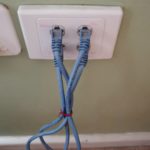
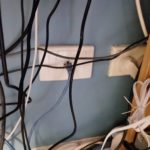


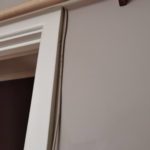


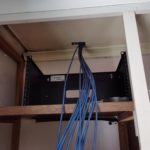

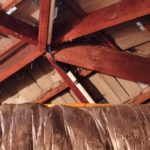
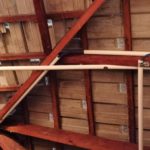
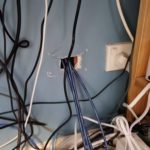
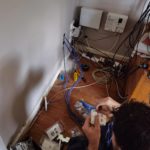
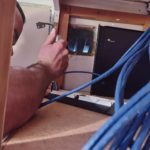



A Network Engineer’s head shaking moment…seeing network cables run back into the wall in the first group of pictures. Good that you showed everything you had very honestly to all so they can understand the importance of proper cabling
Nice write up Phil, I’d be really interested to know what exactly you ended up getting tradies to do and how much that costed? I’m very keen to do a similar thing in my house.
You could get the Unifi gear, and put a PoE powered In-Wall wifi AP in an office / bedroom(s), which have a 2-port gigabit network switch in each, while the HD version has 4 gigabit ports for living room/entertainment centres. It saves having to wire 4 or 5 ports in each room, and each IW can have settings applied in bulk across a home network or office. There’s a few other ways to route/wire rooms and have repeaters for wifi coverage, but if you already have wall sockets, it’s an option rather than putting ceiling mounted options or taking up… Read more »
As addendum, you can run the Unifi controller software on an Rpi3 or 4, along with home-assistant and pihole for DNS ad-blocking. There’s ways to get this working on Docker, or in a VM on a home NAS, but the Docker system can update itself neatly. As for the HDHomerun, the Shield TV works fantastically as a TV client, with very little latency between channel changes, has a decent EPG and looks slightly better than the internal TV. It works better than the provided software, and much faster than Plex. It possibly works as well on other Android TVs, but… Read more »
its a shame the laws are so strict in this country for wiring. running a network cable isn’t rocket science but having to pay an electrician to come out is crazy.
I’ll be undergoing a renovation in a few months and have been thinking of how far to go with hard wired cabling. Makes sense to take advantage of the opportunity. I’m thinking of a few rooms where a single cable run is adequate, but probably 3 rooms where at 2-4 cables/ports could be useful. What are some considerations and tradeoffs for the multi port rooms, from a cost, performance, and functionality perspective of either doing multiple cable runs to those rooms, or just a single cable run and utilise say a 4 port switch at the end to spilt off… Read more »
I decided to run the cables behind the TV for future upgrades…
You just never know what may happen, so I’ve made the decision to put more in than I think I may need. The other consideration I had was each port is limited and if I’m using multiple devices at a high capacity that will max out a single cable.
Most users won’t see that as an issue, but I really wanted this to be a future proof option for my home.
If you can run the cables during a reno, run the cables. They will cost hardly anything when the walls are just framing and you never know what you might want to do in future.
Question, are you licensed as the ACMA made it mandatory some years back.
“The final pieces of the puzzle were going to be getting licenced tradies in to complete the tasks. The cupboard will need power for the hardware, a network cabler to terminate cables to code and an antenna port in the cupboard for my HD Homerun.”
He got a licensed tradie to do it.
Are the cat6 cable 10g ready?
Are you a licensed cabler?
“The final pieces of the puzzle were going to be getting licenced tradies in to complete the tasks. The cupboard will need power for the hardware, a network cabler to terminate cables to code and an antenna port in the cupboard for my HD Homerun.”
He got a licensed tradie to do it.
Cool read. I went a different way… server rack, UTM… multiple access points and walk away… AirPlay and print works nicely from any area on my humble 630sq block. I’m on NBN wireless so I’m never going to expect nor receive decent internet bandwidth, but it works for now… keeps the random server bot port scans at bay 🙂
Having been in the industry for over 40 years (including completing an open license in cabling (telecommunications & low voltage mains)), can totally see where you are coming from!
Sadly I was involved in freak accident in 2003 which saw me hospitalised for 2 months & a further 6 to 8 months to fully recover.
Nonetheless has not impeded too drastically my career in IT.
If given the opportunity, my partner & I wish to buy the property we are renting and make some realistic renovations to include a server room in the mix!
Ehhh. There’s cat 8 if you’re talking of future proofing.
😊. PS:it does not make a huge difference
I can’t see me needing higher speeds than 10Gbps in my home…
I’m really happy with what we have!
Careful, remember Abbot said no Australian home would need more than 25mbps
Might need to be 10g in 10 years time thou
There’s also fibre and SFP connectors, but we’re talking about realistic future proofing. By the time he would need to upgrade from cat 6, 10Gb technology will be a lot cheaper than it is now, to the point that it would be cheaper just to run new cabling then.
Nice write up, good stuff.
My previous house was like you described, cables running down hallways and along floors. I’d decided to get a rack and make it neat but sold the house instead.
This place isn’t bad with a couple of EoP devices. It got messy adding in a wireless repeater, switch and cables across the office (detached from the house, attached to the side of the shed, used as storage) when I started working from home.
Good stuff Phil. A reminder that I really would like to improve my network to get more stuff hardwired rather than relying on wifi. Although a mesh system is probably quicker and easier to implement.
And cheaper…
I already have one cable to each of the lounge and the media room, but probably need at least three to each to service additional devices like Chromecast Ultra and PS4…